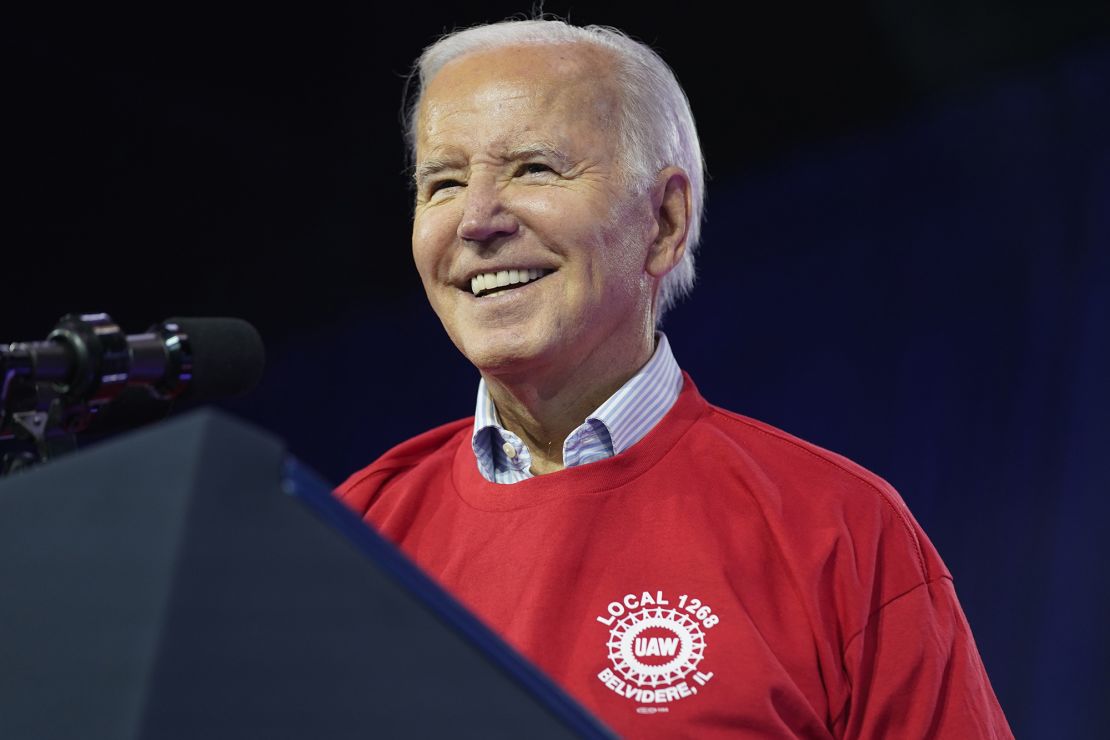General Motors, Stellantis and Ford have closed dozens of US plants since the beginning of this century. Only a handful have ever been brought back to life. Now the United Auto Workers union can add one more.
That’s why US President Joe Biden attended a UAW rally in Belvidere, Illinois, Thursday, along with UAW President Shawn Fain.
Illinois is not a political battleground state like Michigan or Ohio, which have far more auto plants. But Belvidere is ground zero for the union’s successful fight to stop plant closings in its just completed tentative labor agreements with Stellatis, GM and Ford.
It is the site of an assembly plant that was closed in February, leaving 1,200 hourly workers either without a job or forced to transfer to another plant far away from the rural Illinois city of 25,000, about 70 miles west of Chicago.
But that plant is now due to reopen as an assembly plant in 2027, building a new midsize pickup truck. In the meantime, it will start making batteries for electric vehicles and serve as a parts depot for the company. Workers who have been laid off who can’t get one of those jobs or don’t want to move away can get partial pay in the meantime that, together with unemployment benefits, can get them more than 70% of their normal pay.
“It’s definitely unusual that a plant is brought back to life,” said Jeff Schuster, global head of automotive for GlobalData, an industry consultant. The union often will try to bring plants back during negotiations, but typically with limited success.
And that success in the just-completed labor negotiations during the strike at Stellantis is why Fain and Biden both came to Belvidere on Thursday.
“Nobody thought we could accomplish what we accomplished. Re-open Belvidere? Forget it,” Fain said during remarks Thursday.
Biden recalled two massive auto plants that GM and Chrysler used to operate in his home state of Delaware, and what happened when they closed.

“When they shut down, people lost their sense of pride. Neighborhoods were in real trouble. People wonder if they’re going to stick around, what was going to happen to their families,” he said. “So this opening Belvidere again is a gigantic deal as far as I’m concerned.”
‘Willing to tear apart families’
It’s a big deal for Dawn Sims, a 24-year veteran of the plant and a third-generation Chrysler worker in Belvidere, She spoke at the event with Fain and Biden, talking about the stress she and co-workers were put under when Stellantis announced plans to close the plant.
“They were willing to tear apart families, they were willing to tear apart communities,” she said.
She said that with both a son and daughter in high school, she felt she couldn’t relocate her whole family.
“To keep my job, it would mean I’d have to leave my family,” she said. “These were the tough choices we were all having to make.”
Part of the union’s success was its unusual strike strategy. The union struck all three companies together for the first time in its history, but started with strikes at only one assembly plant per company, which gave it the opportunity to add to the scope of the strike six times as it repeatedly turned up the pressure at the bargaining table.
“It was a very different tactic that seemed to work,” said Schuster.
But what really helped were record profits and/or near-record profits at the automakers. Schuster said it’s much tougher to save jobs and stop plant closings when companies are struggling, losing billions and running short on cash, or even just treading water.
The union said that the three unionized automakers, the traditional Big Three, have closed 65 plants and facilities so far this century. Some of those jobs were lost to outsourcing, either to suppliers or in some cases foreign plants, and some to automation.
Strong sales help save jobs
But much of the loss occurred due to lost market share. In 1999, data from Edmunds shows the traditional Big Three had total US sales of 11.5 million vehicles and 68% of the market. By last year, that had fallen by 51%, with US sales of just 5.7 million vehicles and only 41% of the market.
But with strong demand for cars helping fuel record car prices, the unions were in a strong position. “Record profits, record contracts” became one of its slogans on the picket lines.
Belvidere isn’t the first plant brought back to life. But it’s one of few.
In the past, just getting an automaker to drop future plans to shut down a plant was considered a win for the union.
That’s what happened with a plant in Sterling Heights, Michigan, operated by Stellantis predecessor Chrysler, which appeared slated for closing as part of its 2009 bankruptcy, and then again by 2012. But the plant has continued to operate to this day.
And it’s what happened with the last GM assembly plant in Detroit, its Hamtramck Assembly plant, that as part of the 2019 labor deal was closed in early 2020 and re-tooled to make electric pickups, reopening in November 2021.
Among the few plants that literally came back from the dead were GM assembly plants that were closed during the 2009 bankruptcy, including one in Spring Hill, Tennessee, and one in Orion Township, Michigan, that were revived as part of the 2011 labor deal.
But other plants that the union tried to save, including GM’s massive assembly plant in Lordstown, Ohio, and transmission plants in Warren, Michigan, and Baltimore have been permanently shuttered.








